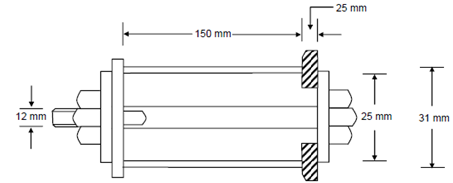Determine the final stresses in the bolt:
A steel bolt of diameter 12 mm and length 175 mm is used to clamp a brass sleeve of length 150 mm to a rigid base plate as in Figure. The sleeve has an internal diameter of 25 mm and a wall thickness of 3 mm. The thickness of the base plate is 25 mm. Initially, the nut is tightened until there is tensile force of 5 kN in the bolt. The temperature is now increased by 100°C. Determine the final stresses in the bolt and the sleeve.
For computation purposes, take following values:
Eb = 105 GNm-2 ; Es = 210 GNm-2
αb = 20 × 10 -6 K-1 ; αs = 12 × 10 -6 K-1

Figure
Solution
Let the free thermal expansions of steel and brass be Δs and Δb and Δ be the common expansion. Then
Δs = (175) (12 × 10-6) (100) = 0.21 mm
Δb = (150) (22 × 10-6) (100) = 0.3 mm
If the initial stresses in steel and brass due to 5 kN load are σs1 and σb1, then
σs1 = +( 5 × 103 × 4)/π (12)2 = + 44.21 N/mm2 (Tensile)
σb1 = +( 5 × 103 × 4)/π (312 - 252) = + 44.21 N/mm2 (Compressive)
Equilibrium of thermal stresses σs2 and σb2 requires that
σs2 × π (12)2/4 +σb2 × π (312 - 252 )/4 = 0
or 3 σs2 + 7 σb2 = 0
The thermal strains are given by
εs = (Δ- Δs )/175 and εb = (Δ- Δb )/150
Thus, the thermal stresses are as follows:
σs2 = 210/175 (Δ- Δs) × 103 N/mm2
and σb2 = 105/150 (Δ- Δb) × 103 N/mm2
Substituting these in the equilibrium equation,
3 × 210/175 (Δ - 0.21) × 103 + 7 × 105/150 (Δ - 0.30) × 103 = 0
Hence, Δ = 0.262 mm
Thus,
σs2 = 210/175 (0.262- 0.21) × 103 = + 62.26 N/mm2 (Tensile)
σb2 = 105/150 (0.262- 0.3) × 103 = - 26.28 N/mm2 (Compressive)
Total stresses are therefore as follows:
σs = σs1 + σs2 = - 106.5 N/mm2 (Tensile)
σb = σb1 + σb2 = - 4.56 N/mm2 (Compressive)